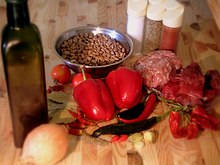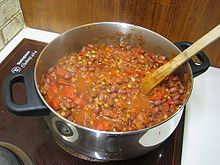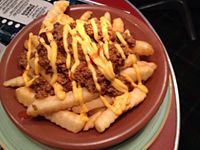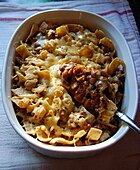
Mexican cuisine consists of the cooking cuisines and traditions of the modern country of Mexico. Its earliest roots lie in Mesoamerican cuisine. Mexican cuisine ingredients and methods begin with the first agricultural communities such as the Olmec and Maya who domesticated maize, created the standard process of nixtamalization, and established their foodways. Successive waves of other Mesoamerican groups brought with them their cooking methods. These included: the Teotihuacanos, Toltec, Huastec, Zapotec, Mixtec, Otomi, Purépecha, Totonac, Mazatec, Mazahua, and Nahua. With the Mexica formation of the multi-ethnic Triple Alliance, culinary foodways became infused.

An enchilada is a Mexican dish consisting of a corn tortilla rolled around a filling and covered with a savory sauce. Enchiladas can be filled with various ingredients, including meats, cheese, beans, potatoes, vegetables, or combinations. Enchilada sauces include chili-based sauces, such as salsa roja, various moles, tomatillo-based sauces, such as salsa verde, or cheese-based sauces, such as chile con queso.
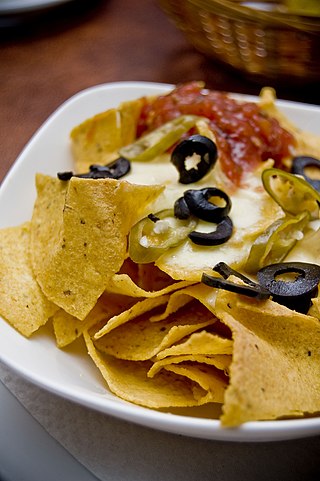
Nachos are a Tex-Mex culinary dish consisting of tortilla chips or totopos covered with cheese or cheese sauce, as well as a variety of other toppings and garnishes, often including meats, vegetables, and condiments such as salsa, guacamole, or sour cream. At its most basic form, nachos may consist of merely chips covered with cheese, and served as an appetizer or snack, while other versions are substantial enough as a main course. The dish was created by, and named after, Mexican restaurateur Ignacio "Nacho" Anaya, who created it in 1943 for American customers at the Victory Club restaurant in Piedras Negras, Coahuila.

Fried rice is a dish of cooked rice that has been stir-fried in a wok or a frying pan and is usually mixed with other ingredients such as eggs, vegetables, seafood, or meat. It is often eaten by itself or as an accompaniment to another dish. Fried rice is a popular component of East Asian, Southeast Asian and certain South Asian cuisines, as well as a staple national dish of Indonesia. As a homemade dish, fried rice is typically made with ingredients left over from other dishes, leading to countless variations. Fried rice first developed during the Sui dynasty in China.

Salvadoran cuisine is a style of cooking derived from the nation of El Salvador. The indigenous foods consist of a mix of Amerindian cuisine from groups such as the Lenca, Pipil, Maya Poqomam, Maya Chʼortiʼ, Alaguilac and Cacaopera peoples and some African influences. Many of the dishes are made with maize (corn). There is also heavy use of pork and seafood. European ingredients were incorporated after the Spanish conquest.

Frito pie is a dish popular in the Midwestern, Southeastern, and Southwestern United States, whose basic ingredients are chili, cheese, and corn chips. Additions can include salsa, refried beans, sour cream, onion, rice, or jalapeños. There are many variations and alternative names used by region. Frito pie can be prepared in a casserole dish, but an alternate preparation can be in a single-serve Fritos-type corn chip bag with various ingredients as toppings.

New Mexican cuisine is the cuisine of the Southwestern US state of New Mexico. The region is primarily known for its fusion of Pueblo Native American cuisine with Hispano Spanish and Mexican cuisine originating in Nuevo México. This Southwestern culinary style is popular beyond the current boundaries of New Mexico, and is found throughout the old territories of Nuevo México and the New Mexico Territory, today the state of Arizona, parts of Texas, and the southern portions of Colorado, Utah, and Nevada.

Picadillo is a traditional dish in many Latin American countries including Mexico and Cuba, as well as the Philippines. It is made with ground meat, tomatoes, and also raisins, olives, and other ingredients that vary by region. The name comes from the Spanish word picar, meaning "to mince".

Adobada is a preparation for many dishes that are common in Mexican cuisine. Adobada is generally pork marinated in a "red" chili sauce with vinegar and oregano, but it can refer to different types of meat and to marinades closer to al pastor. It is generally served on small, pliable maize tortilla along with sautéed vegetables and cheese.
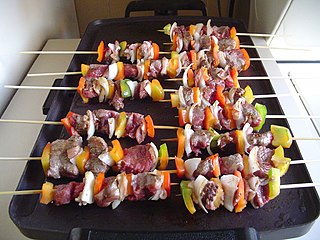
Honduran cuisine is a fusion of Mesoamerican, Spanish, Caribbean and African cuisines. There are also dishes from the Garifuna people. Coconut and coconut milk are featured in both sweet and savory dishes. Regional specialties include sopa de caracol, fried fish, tamales, carne asada and baleadas. Other popular dishes include meat roasted with chismol and carne asada, chicken with rice and corn, and fried fish with pickled onions and jalapeños. In the coastal areas and the Bay Islands, seafood and some meats are prepared in many ways, including with coconut milk. Among the soups the Hondurans enjoy are bean soup, mondongo soup, seafood soups and beef soups. Generally all of these soups are mixed with plantains, yuca, and cabbage, and served with corn tortillas.

Entomatadas are a Mexican dish made of a folded corn tortilla which has first been fried in oil and then bathed in a tomato sauce made from tomatoes, garlic, onion, oregano, chile serrano (optional) and salt. The recipes for the tomato sauce vary by cook. The tortilla can be filled with a number of different ingredients, however the most common are chicken, beef, cheese or beans. The chicken and beef have most often been pressure cooked so that the meat is tender and can be pulled apart with the fingers. More tomato sauce is poured on top of the filled tortillas and the dish is garnished with sour cream, shredded cheese and slices of white onion.

Most traditional foods in Guatemalan cuisine are based on Maya cuisine, with Spanish influence, and prominently feature corn, chilies and beans as key ingredients. Guatemala is famously home to the Hass avocado.

Chilean cuisine stems mainly from the combination of traditional Spanish cuisine, Chilean Mapuche culture and local ingredients, with later important influences from other European cuisines, particularly from Germany, the United Kingdom and France. The food tradition and recipes in Chile are notable for the variety of flavours and ingredients, with the country's diverse geography and climate hosting a wide range of agricultural produce, fruits and vegetables. The long coastline and the peoples' relationship with the Pacific Ocean add an immense array of seafood to Chilean cuisine, with the country's waters home to unique species of fish, molluscs, crustaceans and algae, thanks to the oxygen-rich water carried in by the Humboldt Current. Chile is also one of the world's largest producers of wine and many Chilean recipes are enhanced and accompanied by local wines. The confection dulce de leche was invented in Chile and is one of the country's most notable contributions to world cuisine.

A sope is a traditional Mexican dish consisting of a fried masa base with savory toppings. Also known as picadita, it originates in the central and southern parts of Mexico, where it was sometimes first known as pellizcadas. It is an antojito, which at first sight looks like an unusually thick tortilla with vegetables and meat toppings.

Mexican street food, called antojitos, is prepared by street vendors and at small traditional markets in Mexico. Street foods include tacos, tamales, gorditas, quesadillas, empalmes, tostadas, chalupa, elote, tlayudas, cemita, pambazo, empanada, nachos, chilaquiles, fajitas, tortas, even hamburgers and hot dogs, as well as fresh fruits, vegetables, beverages and soups such as menudo, pozole and pancita. Most are available in the morning and the evening, as mid-afternoon is the time for the main formal meal of the day. Mexico has one of the most extensive street food cultures in Latin America, and Forbes named Mexico City as one of the foremost cities in the world in which to eat on the street.

Bean dip is a type of dipping sauce made using beans or refried beans as a primary ingredient. It is typically served with tortilla chips, and can also be served with other foods such as crackers and crudités. Various types of beans are used, and fresh-cooked, canned or flaked beans can be used. Various additional ingredients are used in its preparation, such as onion, garlic, chili peppers and spices, and it is sometimes garnished with some ingredients. Bean dip can be served cold, at room temperature, or hot. Bean dip is sometimes used as an ingredient in the preparation of other dishes such as burritos and quesadillas.
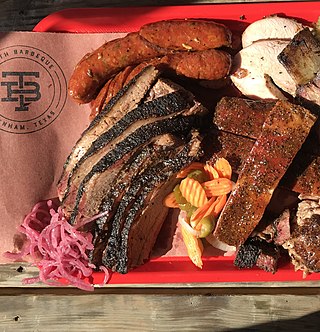
Texan cuisine is the food associated with the Southern U.S. state of Texas, including its native Southwestern cuisine–influenced Tex-Mex foods. Texas is a large state, and its cuisine has been influenced by a wide range of cultures, including Tejano/Mexican, Native American, Creole/Cajun, African-American, German, Czech, Southern and other European American groups. The cuisine of neighboring states also influences Texan cuisine, such as New Mexican cuisine and Louisiana Creole cuisine. This can be seen in the widespread usage of New Mexico chiles, Cayenne peppers, and Tabasco sauce in Texan cooking.

Oaxacan cuisine is a regional cuisine of Mexico, centered on the city of Oaxaca, the capital of the eponymous state located in southern Mexico. Oaxaca is one of the country's major gastronomic, historical, and gastro-historical centers whose cuisine is known internationally. Like the rest of Mexican cuisine, Oaxacan food is based on staples such as corn, beans, and chile peppers, but there is a great variety of other ingredients and food preparations due to the influence of the state's varied geography and indigenous cultures. Corn and many beans were first cultivated in Oaxaca. Well-known features of the cuisine include ingredients such as chocolate, Oaxaca cheese, mezcal, and grasshoppers (chapulines), with dishes such as tlayudas, Oaxacan-style tamales, and seven notable varieties of mole sauce. The cuisine has been praised and promoted by food experts such as Diana Kennedy and Rick Bayless and is part of the state's appeal for tourists.
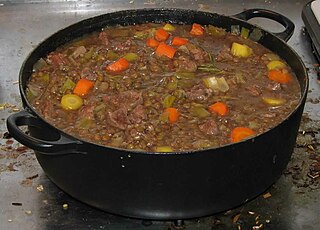
A stew is a combination of solid food ingredients that have been cooked in liquid and served in the resultant gravy. Ingredients can include any combination of vegetables and may include meat, especially tougher meats suitable for slow-cooking, such as beef, pork, venison, rabbit, lamb, poultry, sausages, and seafood. While water can be used as the stew-cooking liquid, stock is also common. A small amount of red wine or other alcohol is sometimes added for flavour. Seasonings and flavourings may also be added. Stews are typically cooked at a relatively low temperature, allowing flavours to mingle.


